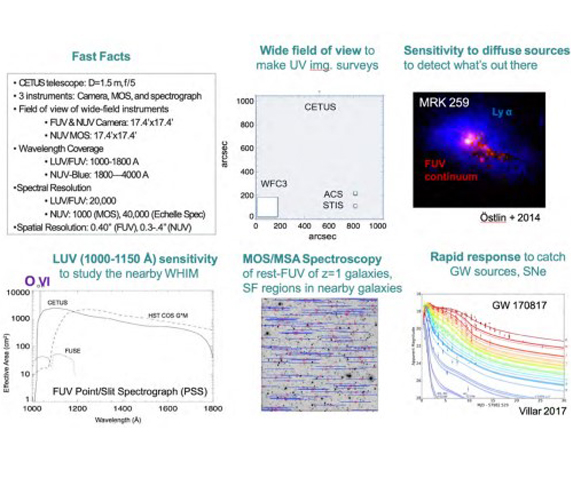Progress Report on the All-UV Probe Mission Concept, CETUS
ABSTRACT
We report on the status of CETUS, an all-UV, Probe-class mission concept to be evaluated by the Astro2020 Steering Panel. This report expands and updates the scientific uses of CETUS and CETUS technology as described earlier by Kendrick et al. (2019). The major updates derive form technological advances that promise to make CETUS a scientifically more powerful and long-lived space observatory than originally proposed. A long, useful lifetime will be needed to fulfill the future needs of the astronomical and planetary-science community.
1. INTRODUCTION
After 30 years in orbit and 11years since the last servicing mission, the Hubble Space Telescope is old. Yet every year, Hubble is overloaded with observing proposals. This oversubscription is partly due to Hubble’s unique capabilities, one of which is that Hubble gives access to the UV, a spectral region rife with astronomical diagnostics. But at some time, Hubble will end. What will take its place? We describe a NASA Probe-class, all-UV mission concept, called CETUS which should be a worthy successor. We proposed to study CETUS to NASA four years ago and were selected. We find that, except for exquisite imagery, CETUS can do most of the things Hubble does now, yet is enough different from Hubble to provide new kinds of UV observations. Figure 1 summarizes the CETUS instruments and their capabilities.

Figure 1. Visual summary of the unique features of the CETUS space telescope.
In 2016, we proposed a 1.5-m rather fast (f/5) telescope with three instruments: a far-UV/near-UV camera like Hubble’s ACS or STIS but having a wide field, a far-UV/near-UV spectrograph like Hubble’s COS and STIS, and a new instrument: a multi-object spectrograph with a microshutter array like that in JWST’s NIRMOS. We were careful to propose only high-heritage components like those already in Hubble and JWST to give credibility to our contention that CETUS could be built on a Probe budget.
Now in 2020, we have the same telescope and instruments but many critical components within these instruments are new and improved. We will describe these improvements in Section 3. In addition, we have witnessed new kinds of astrophysical events like the neutron star binary merger, and we have benefitted from the explosion of ideas expressed in the Astro2020 Science White Papers; the White Paper, “UV-based Science in the Solar System: Advances and Next Steps” submitted by Hendrix et al. (2020) to the Planetary Science and Astrobiology Decadal Survey, 2023-2032; and White Papers submitted to “Voyage to 2050”, the next planning cycle of the ESA science program. These papers have had a profound effect, which we describe in Section 2.
Для продолжения чтения вы можете скачать полную версию материала по ссылке ниже